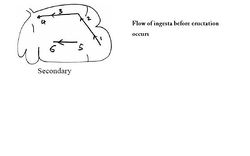Diferencia entre revisiones de «Eructo - Anatomía y Fisiología»
(Página creada con '==Introduction== Eructation is the release of gases from the stomach through the oesophagus. Carbon dioxide, methane, hydrogen and other v...') |
|||
| Línea 1: | Línea 1: | ||
==Introduction== | ==Introduction== | ||
| − | Eructation is the release of gases from the stomach through the [[Oesophagus - | + | Eructation is the release of gases from the stomach through the [[Oesophagus - Anatomía & Fisiología|oesophagus]]. Carbon dioxide, methane, hydrogen and other volatile products are produced in the [[Rumen - Anatomía & Fisiología|rumen]] through the fermentation of food by microorganisms and most of these gases are then released through eructation. |
| − | Not all of the carbon dioxide produced in the [[Rumen - | + | Not all of the carbon dioxide produced in the [[Rumen - Anatomía & Fisiología|rumen]] is released through eructation. Some of the gas is absorbed directly over the [[Rumen - Anatomía & Fisiología|rumen]] wall. If gas release does not occur, or gas elimination does not equal gas production, a condition called [[Bloat|bloat]] will arise. |
| − | == | + | ==Proceso== |
[[Image:Diagram of eructation.jpg|thumb|right|250px|Diagram of Eructation - Copyright RVC 2008]] | [[Image:Diagram of eructation.jpg|thumb|right|250px|Diagram of Eructation - Copyright RVC 2008]] | ||
| − | The process of eructation includes [[Rumen - | + | The process of eructation includes [[Rumen - Anatomía & Fisiología#Ruminoreticular contraction|ruminal contractions]] (no reticular contribution). Before eructation can occur the cardia must be cleared of liquid ingesta, as the cardia is reflexly closed on contact with the liquid [[Rumen - Anatomía & Fisiología|rumen]] contents. Contractions start in the ventral sac and spread to the dorsal sac. Contractions spread caudally to cranially over the [[Rumen - Anatomía & Fisiología|rumen]]. Ruminal gas is forced towards the cranial cardiac area where it is aspirated into the [[Oesophagus - Anatomía & Fisiología|oesophagus]]. The gases are moved orally by an antiperistaltic wave passing through the relaxed '''pharyngoesophageal sphincter''' into the [[Faringe - Anatomía & Fisiología|faringe]]. Some of the eructated gas passes to the lungs, whilst the rest is released from the [[Cavidad Oral - Resumen - Anatomía & Fisiología|cavidad oral]]. |
==Gas Volume== | ==Gas Volume== | ||
| Línea 17: | Línea 17: | ||
| − | [[ | + | [[Categorgía:Stomach - Anatomía & Fisiología]] |
Revisión del 16:47 5 may 2011
Introduction
Eructation is the release of gases from the stomach through the oesophagus. Carbon dioxide, methane, hydrogen and other volatile products are produced in the rumen through the fermentation of food by microorganisms and most of these gases are then released through eructation.
Not all of the carbon dioxide produced in the rumen is released through eructation. Some of the gas is absorbed directly over the rumen wall. If gas release does not occur, or gas elimination does not equal gas production, a condition called bloat will arise.
Proceso
The process of eructation includes ruminal contractions (no reticular contribution). Before eructation can occur the cardia must be cleared of liquid ingesta, as the cardia is reflexly closed on contact with the liquid rumen contents. Contractions start in the ventral sac and spread to the dorsal sac. Contractions spread caudally to cranially over the rumen. Ruminal gas is forced towards the cranial cardiac area where it is aspirated into the oesophagus. The gases are moved orally by an antiperistaltic wave passing through the relaxed pharyngoesophageal sphincter into the faringe. Some of the eructated gas passes to the lungs, whilst the rest is released from the cavidad oral.
Gas Volume
In the dairy cow, 0.5-1 L of gas is produced per minute in the ruminoreticulum. The exact amount of gas absorbed into the blood and lymph is unknown, but the majority is eliminated by eructation.
